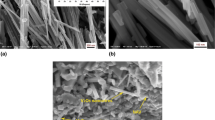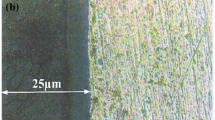The objective of searching the optimum applied load was to minimize friction and decrease wear in mechanical moving components. The friction and wear behaviors of TiAl-10wt.%V2O5 nanowires (TiAl-10wt.%V2O5) were evaluated sliding against the fixed Al2O3 balls with the Vickers hardness of 18.07 GPa at the applied loads of 6-24 N. The testing results showed that the smaller friction coefficient and wear rate of TiAl-10wt.%V2O5 were obtained at 18 N, if compared to those at 6, 12 and 24 N. The smaller friction coefficient and wear rate were mainly attributed to the forming of cambiform structure of large crystalline grain, the higher totals of oxide interionic potential and the higher thickness of friction layer at 18 N, if compared to those at the other applied loads. It was obvious that the applied load of 18 N was reasonable for obtaining the lower sliding friction coefficient and the less wear rate of TiAl-10wt.%V2O5.














Similar content being viewed by others
References
A.V. Kartavykh, M.V. Gorshenkov, V.D. Danilov, V.V. Tcherdyntsev, and N.V. Andreev, Tribochemistry of dry-sliding wear of structural TiAl(Nb, Cr, Zr)B, La intermetallics family against the chromium steel, Tribol. Int., 2015, 90, p 270–277
K. Gebauer, Performance, tolerance and cost of TiAl passenger car valves, Intermetallics, 2006, 14, p 355–360
T. Sun, Q. Wang, D.L. Sun, G.H. Wu, and Y. Na, Study on dry sliding friction and wear properties of Ti2AlN/TiAl composite, Wear, 2010, 268, p 693–699
R.G. Vargas, Wear mechanisms of WC inserts in face milling of gamma titanium aluminides, Wear, 2005, 259, p 1160–1167
K. Miyoshi, B. Lerch, and S. Draper, Fretting wear of Ti–48Al–2Cr–2Nb, Tribol. Int., 2003, 36, p 145–153
A. Rastkar, A. Bloyce, and T. Bell, Sliding wear behaviour of two gamma-based titanium aluminides, Wear, 2000, 240, p 19–26
H.J. Zhang, Z.Z. Zhang, and F. Guo, Studies of the influence of graphite and MoS2 on the tribological behaviors of hybrid PTFE/Nomex fabric composite, Tribol. Trans., 2011, 54(3), p 417–423
S. Bathula, M. Saravanan, and A. Dhar, Nanoindentation and wear characteristics of Al/SiCp nanocomposites synthesized by high energy ball milling and spark plasma sintering, J. Mater. Sci. Technol., 2012, 28(11), p 969–975
L. Zhang, J.K. Xiao, and K.C. Zhou, Sliding wear behavior of silver molybdenum disulfide composite, Tribol. Trans., 2012, 55(4), p 473–480
N. Fateh, G. Fontalvo, G. Gassner, and C. Mitterer, The beneficial effect of high-temperature oxidation on the tribological behaviour of V and VN coatings, Tribol. Lett., 2007, 28, p 1–7
R. Franz, Vanadium containing self-adaptive low-friction hard coatings for high-temperature applications A review, Surf. Coat. Technol., 2013, 228, p 1–13
N. Fateh, G. Fontalvo, and C. Mitterer, Tribological properties of reactive magnetron sputtered V2O5 and VN–V2O5 coatings, Tribol. Lett., 2008, 30, p 21–26
R. Franz, J. Neidhardt, B. Sartory, and R. Kaindl, High-temperature low-friction properties of vanadium-alloyed AlCrN coatings, Tribol. Lett., 2006, 23, p 101–107
P. Mayrhofer, P.E. Hovsepian, C. Mitterer, and W.D. Münz, Calorimetric evidence for frictional self-adaptation of TiAlN/VN superlattice coatings, Surf. Coat. Technol., 2004, 177, p 341–347
P.F. Wang, M. Hirose, Y. Suzuki, and K. Adachi, Carbon tribo-layer for super-low friction of amorphous carbon nitride coatings in inert gas environments, Surf. Coat. Technol., 2013, 221, p 163–172
Q. Zhu, X.L. Shi, and W.Z. Zhai, Research on the thickness of the friction layer of Ni3Al matrix composites with graphene nanoplatelets, Tribol. Lett., 2015, 59(3), p 1–9
ASTM Standards E92-82, Standard test method for vickers hardness of metallic materials, in ASTM International West Conshohocken PA, 2003
ASTM Standards B962-08, Standard test methods for density of compacted or sintered powder metallurgy (PM) products using Archimedes’ principle, in ASTM International West Conshohocken PA, 2008
ASTM Standards G99-95, Standard test method for wear testing with a pin-on-disk apparatus, in ASTM International West Conshohocken PA, 1995
R. Tyagi, D.S. Xiong, and J.L. Li, Effect of load and sliding speed on friction and wear behavior of silver/h-BN containing Ni-base P/M composites, Wear, 2011, 270, p 423–430
A. Erdemir, A crystal chemical approach to the formation of self-lubricating nanocomposite coatings, Surf. Coat. Technol., 2005, 200, p 1792–1796
T. Kato, M. Kawaguchi, M.M. Sajjad, and J. Choi, Friction and durability characteristics of ultrathin perfluoropolyether lubricant film composed of bonded and mobile molecular layers on diamond-like carbon surfaces, Wear, 2004, 257, p 909–915
N.E. Beliardouha, K. Bouzida, C. Nouveaub, B. Tlili, and M.J. Walock, Tribological and electrochemical performances of Cr/CrN and Cr/CrN/CrAlN multilayer coatings deposited by RF magnetron sputtering, Tribol. Int., 2015, 82, p 443–452
L. He, Y.F. Tan, X.L. Wang, Q.F. Jing, and X. Hong, Tribological properties of laser cladding TiB2 particles reinforced Ni-base alloy composite coatings on aluminum alloy, Rare Met., 2015, 34(11), p 789–796
B. Bhushan, Introduction to Tribology, S.R. Ge, Ed., China Machine Press, Beijing, 2006, p 67–69
Q. Li, J.B. Luo, and V.L. Popov, Contact Mechanics and Friction Physical Principles and Applications, Tsinghua University Press, Beijing, 2011, p 46–47
Z.M. Liu, Tribological Theory and Design, Wuhan University of Technology Press, Wuhan, 2009, p 47–48
T.J. Rupert and C.A. Schuh, Sliding wear of nanocrystalline Ni–W: structural evolution and apparent breakdown of Archard scaling, Acta Mater., 2010, 58(12), p 4137–4148
Acknowledgments
This work was supported by the National Natural Science Foundation of China (51275370) and the Fundamental Research Funds for the Central Universities (2016-YB-017 and 2016-zy-014). Authors were grateful to M.J. Yang, S.L. Zhao and W.T. Zhu in Material Research and Test Center of WUT for their kind help with EPMA and FESEM.
Author information
Authors and Affiliations
Corresponding author
Rights and permissions
About this article
Cite this article
Yang, K., Shi, X., Zou, J. et al. The Research on the Bionic Friction Layers of TiAl-10wt.%V2O5 Nanowires at the Applied Loads of 6-24 N. J. of Materi Eng and Perform 25, 5391–5399 (2016). https://doi.org/10.1007/s11665-016-2345-4
Received:
Revised:
Published:
Issue Date:
DOI: https://doi.org/10.1007/s11665-016-2345-4




